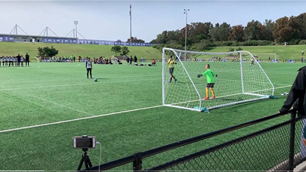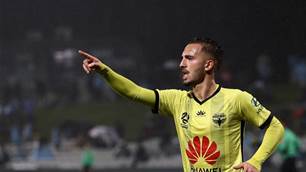EXCLUSIVE: He played at a star-studded Real Madrid and Red Star in the 1980s and was a regular in a classy Yugoslavia side. Meet Cairns resident and wanna-be A-League coach, Milan Jankovic.
To see the AC Milan Soccer School training session...
Sitting in the stands at Homebush's athletics centre in Sydney, quietly spoken Milan Jankovic, 49, cuts an august figure.
Tanned, relaxed and thoughtful, the midfielder from Sarajevo who was snapped up by Leo Beenhakker's Real Madrid in 1986 seems content with "the good life" as he calls it, in tropical Cairns with his Aussie wife and kids.
But after two decades of years of being on the periphery of Australian football, he senses it's time to contribute to our game. That's if we want him.
Jankovic arrived in Australia a 30-year-old in 1991. Incredibly, he wasn't lured into playing for an NSL side. He was looking for a beach house, family time and early retirement after the highs of playing for Red Star and at the Bernabeu. His Cairns-born wife lured him to north Queensland and he's been there for most of the last 19 years.
More of that later...
After rising through the ranks at Red Star Belgrade in the 1980s - a Serbian football institution - a dream move to Real Madrid was his crowning glory. After starring for Red Star in a Champions League match against the Spanish giants, they soon snapped him up.
"I wasn't one of the biggest stars in my country at the time, but I was quite lucky to play Real Madrid home and away though," he tells au.fourfourtwo.com. "Both games I played exceptionally well. And Beenhakker [the Real coach] needed one midfield player."
It signalled the start of two unforgettable years from 1986.
"They are so fanatical. They treat you like a king, he says. "A great two years playing alongside Emile Butragueno, Hugo Sanchez, Hector Camacho, Michel Santilliano, Martin Vasquez, Ricardo Gallego. We won the Spanish League twice but lost in the semis of the Champions League to PSV.
"Our team had a generation of players who played in the Mexico World Cup in 1986."
Speaking of World Cups, Jankovic's exit from the Yugoslav national team was the catalyst for him quitting football and ending up in Australia in the early 90s.
Playing in six World Cup qualifiers on the road to Italia 90, an injury robbed him of his place in the team. And the holding midfielder couldn't get back in when fit again, with fiery coach Ivica Osim insisting on leaving Jankovic out.
The Yugoslav side were a breath of fresh air finishing in the quarter finals. It was a side of Stojkovic, Susic, Pancev, Prosinecki, Savicevic and others.
Edged out on penalties in the quarter finals by Maradona's Argentina, Yugoslavia's technical superiority and refreshing brand of passing football was widely admired.
But Jankovic's chance of playing on the biggest stage was gone. So, his dream of retiring somewhere on the beach was fast-tracked and he ended up in Cairns shortly after.
"It was the reason why I quit football. Osim was a good coach but I was dropped," he says rather solemnly.
So he arrived in NSL-Australia. Disillusioned with football after the national team low, all he wanted to do was enjoy living in tropical north Queensland.
Coincidentally, down south, another former Red Star man was starring in the NSL: Milan Ivanovic. The ball-playing central defender had got his Aussie citizenship and till he was 38 was still giving master classes about how to defend and play out from the back.
Ivanovic, of Adelaide City, remains one of the most cultured defenders ever to wear the green and gold. Jankovic stays in touch with the player but you can't help but wonder the impact he would've had if he too played in the NSL. We'll never know...
Jankovic is in Sydney at the invitation of his old Red Star mate Misha Radovic - a respected junior coach currently working for the AC Milan Soccer Schools alongside former AC midfielder Andrea Icardi.
Radovic invited Jankovic down to give their students an insight into what it takes to make it in Europe.
And when it comes to youth development, Jankovic says it's all about finessing their technique from the age of six onwards.
"These boys at the institute who are already 15 or 16, so it was too late to work on specific technical development. But for me, from six up to around ten or 12, you need to work on their technique and skills.
"Just play with the ball, forget about tactics or positioning. Just more touches. When you are comfortable with the ball, then you can do different things. It's crucial. Six to 12."
He adds though that he sees there is a growing emphasis on this approach, particularly with the SSG revolution working through the junior system.
Jankovic holds UEFA A and B licences. He's been on the periphery of Aussie football since arriving although he's had stints at institute level.
There was a spell in the mid-90s at the AIS with Steve O'Connor and Ray Junna. And he worked in the northern territory as a development officer. Jankovic also spent three years in Tonga as national team coach.
Speaking of national teams, he's followed the progress of the Australian national team and says the Dutch coaching revolution has been the right move at the right time. But he hopes we don't replicate the cautious approach across our development footprint.
"It's not old-fashioned but you need to be more flair, more attacking style, to be honest," he says of the national team but adds: "I don't think Australian national team is as strong as the previous World Cup so you probably need to take this approach to get success to go to the World Cup.
"And I also expect them to be playing the same style in the World Cup because we don't have the quality to play very attacking very entertaining if you don't have players of that calibre.
"So you need to take a little bit more conservative approach or defensive approach to make success and at the end of the day, everyone is looking at results. That's how we measure coach performance.
"But for me, the national technical director needs to take a different approach to the younger players [compared to the national team] so we can develop better players. Producing better quality players, individuals, who can win you the game.
"With Kewell getting a little older and slower, we don't have that in the national team."
But the A-League is what he has his eyes now firmly on. Jankovic says he's applied for jobs in Australia. Fury was one. He didn't hear back from the previous bid owners.
"It's something I did all my life, so it's a pleasure for me to stay in the game," he says. "I probably need to move away from Cairns to the bigger cities where you can be seen with clubs.
"At the moment I'm looking for different options to move. I'd like to coach in the A-League or even youth A-League. And I think the A-League is getting better and better.
"I think it's very comparative. Look at the Asian Champions League and I think Australian teams have been tactically dominant. Japan is strong because of better quality players but tactically Australia is pretty good."
And while he's in town, Jankovic will catch up with his old Red Star mate Dragan Stojkovic - coach of Newcastle opponents in the ACL on Wednesday night, Nagoya Grampus.
The Stojkovic connection could see Jankovic move to Japan. Or back to Europe. If so, it would be a pity that at a time when the Australian game is looking to develop technically, this quality former player is not utilised in some way.
After all, it's not just the Dutch who can make our game stronger.
Related Articles

Fresh talent flock to ambitious A-League outfit's pro pathway

Why A-League 20/21 is crucial for Olyroos’ medal hopes













